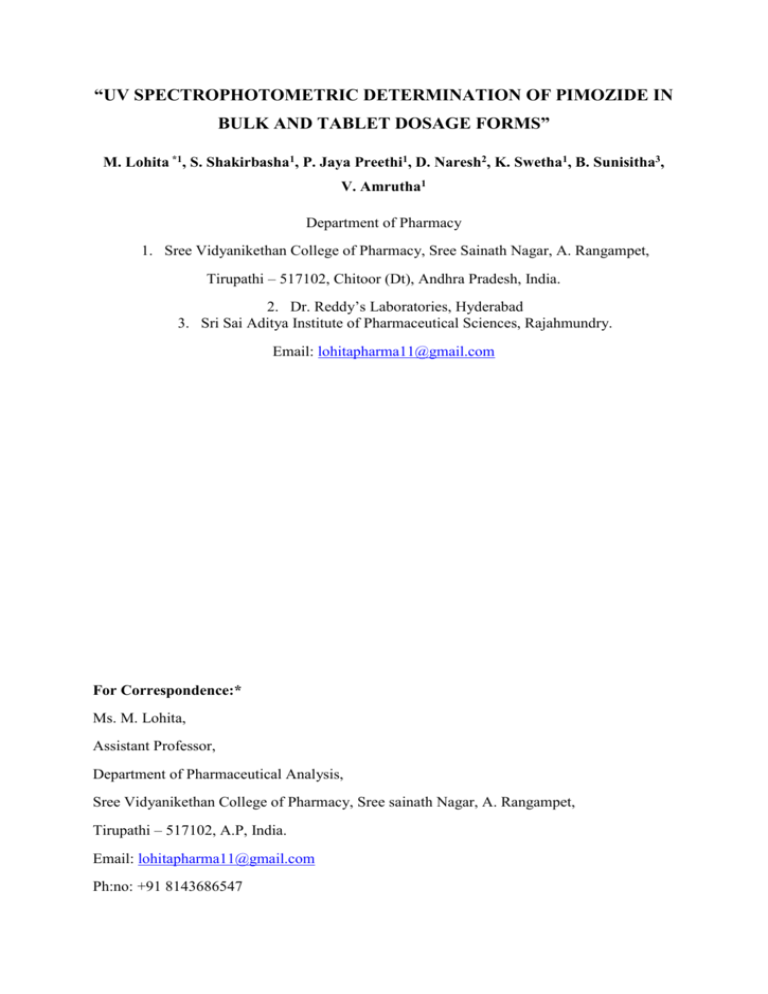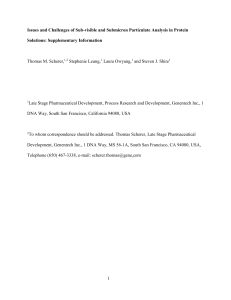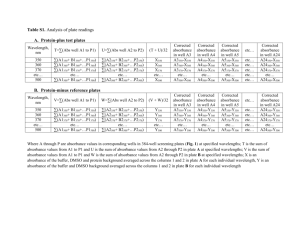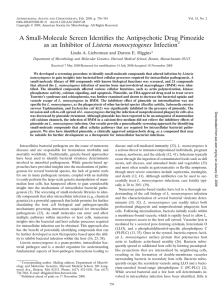uv spectrophotometric determination of pimozide in bulk and tablet
advertisement

“UV SPECTROPHOTOMETRIC DETERMINATION OF PIMOZIDE IN BULK AND TABLET DOSAGE FORMS” M. Lohita *1, S. Shakirbasha1, P. Jaya Preethi1, D. Naresh2, K. Swetha1, B. Sunisitha3, V. Amrutha1 Department of Pharmacy 1. Sree Vidyanikethan College of Pharmacy, Sree Sainath Nagar, A. Rangampet, Tirupathi – 517102, Chitoor (Dt), Andhra Pradesh, India. 2. Dr. Reddy’s Laboratories, Hyderabad 3. Sri Sai Aditya Institute of Pharmaceutical Sciences, Rajahmundry. Email: lohitapharma11@gmail.com For Correspondence:* Ms. M. Lohita, Assistant Professor, Department of Pharmaceutical Analysis, Sree Vidyanikethan College of Pharmacy, Sree sainath Nagar, A. Rangampet, Tirupathi – 517102, A.P, India. Email: lohitapharma11@gmail.com Ph:no: +91 8143686547 Abstract: A simple, selective, precise and accurate UV spectrophotometric determination of pimozide in bulk and pharmaceutical dosage form was developed and validated. The solvent used was methanol and detected at 268 nm at room temperature. The linear regression analysis data for the linearity plot showed good linear relationship with correlation coefficient value, R2 = 0.999 in the concentration range 5 – 25 µg/ml with slope 0.03726, intercept 0.0003. The method was validated according to the International Conference on Harmonization (ICH) guidelines for linearity, range, accuracy, precision and specificity and applied on bulk powder and pharmaceutical formulations. Pimozide was determined in sterile dosage form in range of 99.73% with 0.0243 standard deviation. The accuracy of the method was validated by recovery studies and was found to be significant and under specification limits, with % Recovery 99 – 101.7% (within acceptable range (95 – 105%). Keywords: UV spectrophotometer, Pimozide, Methanol, Validation. 1. INTRODUCTION1-11 Pimozide is an anti-psychotic agent. It is a potent D2 blocker, moderate D1 and D4 blockers1. It is a white –off white powder, odourless2. Chemically it is, 1-(1-(4,4-bis (4-flurophenyl) butyl) -4-piperidinyl)-1,3-di hydro-2H-benzimidazole-2-one3. Fig: 1 Structure of pimozide4 Literature survey reveals that various analytical methods have been reported for the estimation of Pimozide based on different technique, such as; HPLC by using hydro alcoholic meadia (10+ 90)( methanol-water) and LC-ESI/MS method for the quantitative determination of Pimozide in human plasma. The aim of present work is to develop a simple, specific, sensitive and accurate UV spectrophotometric method for the analysis of Pimozide and validate as per ICH guidelines [3]. 2. EXPERIMENTAL11-15 2.1 Reagents and materials Pimozide pure sample was obtained as a gift sample from Edict pharmaceuticals private LTD., Chennai. (Dosage form Label claim: 4 mg, Larap brand name and manufacturer Manas pharma MFG) were procured from the local market. Methanol was purchased from Rankem, Mumbai, India. 2.2 Apparatus The UV Vis spectrophotometer (Shimadzu model) was employed in the method development and assay method validation. 2.3 Methods 2.3.1. Selection of solvent Solubility of the drug in different solvents was performed. Pimozide was soluble in methanol. The drug showed good spectrum and was stable in methanol, so it was selected as a solvent of choice. The absorption maxima of Pimozide were found to be 268nm. 2.3.2. Preparation of standard stock solution Accurately weighed quantity of 100 mg Pimozide reference standard was transferred into 100 ml volumetric flask and dissolved and diluted up to the mark with methanol to give a stock solution having strength 1mg/ml. This stock solution was further diluted with solvent to get a concentration of 100µg/ml. 2.4 Method Validation12-13 2.4.1. Linearity Working standard solutions for the drug having concentration 5, 10, 15, 20 and up to 25µg/ml were prepared by diluting the standard stock solution with a solvent. The absorbance of resulting solutions were measured at wavelength of 268nm against solvent blank and a calibration curve was plotted to get the linearity and regression equation. 2.4.2. Accuracy Accuracy of the method was determined by recovery experiments. To the formulation, the reference standards of the drug were added at the level of 50%, 100%, 150%. The recovery studies were carried out three times and the percentage recovery and %RSD of the recovery were calculated. 2.4.3. Precision The precision of the method was demonstrated by method precision, system precision, interday and intra-day variation studies. The precision studies were performed for the standard concentration. 2.4.4. LOD Limit of detection is the lowest concentration of analyte in a sample that can be detected, but not necessarily quantified. LOD was performed at a wavelength of 268nm for 10ng/ml and the value is 0.190. 2.4.5 LOQ Limit of quantitation is the lowest concentration of analyte in a sample that can be determined with acceptable precision and accuracy under the stated experimental conditions. LOQ was performed at a wavelength of 268 nm for 100ng/ml and the value is 0.577. 2.5 single point standardization13-14 Measurement of absorbance of sample solution and standard solution of a reference substance. The concentration of standard solution should be close to that of sample solution. The concentration of a substance in the sample can be calculated from the proportional relationship that exists between absorbance and concentration. CTest = ( ATest / Astd) × Cstd 2.5.1. preperation of sample solution Take 20 tablets and powder it. Take aquantity of powder equivalent to10mg was taken and transferred in to a 100ml volumetric flosk, dissolve in methanol and volume make up with same solvent. From this adequate dilutions were made within beer’s law concentration and it’s absorbance was measured at 268nm. From this the concentration was found by using earliar equation. The amount of drug present in the formulation can be found by, Amount = (concentration × dilution factor × Avg. weight) / weight taken 2.6 Calibration graph method15 In this method absorbance of number of standard solutions of reference substance at concentration encompassing the sample concentration were measured and calibration graph was plotted. The concentration of analyte in the sample solution was read from the graph as the concentration corresponding to the absorbance of the solution. 2.7 Results and Discussion The present work was aimed comparatively to the earlier literature report in connection to the priority of developing a “UV spectrophotometric determination of Pimozide in bulk and tablet dosage form” as per ICH guidelines. In this current study, the API named Pimozide (anti psychotic) which is the most essential therapeutic agent in treatment of psychosis. Among the analytical techniques available for quantification, the UV spectrophotometric method is an emerging technique reliable in vast areas of research that incited the author to undertake method development and validation as per ICH guidelines for the API. The method followed here was external standard method in which methanol was used as a diluent, and absorbance wavelength was 268nm. The method was validated for all validation parameters as per ICH guidelines. The linearity range for Pimozide was 5 – 25 µg/ml. with R2 value of 0.999. The % RSD for method and system precision was < 2%. The method has been validated for assay of sterile dosage forms with 99%. The accuracy of the method was validated by recovery studies and was found to significant and under specification limits, with % Recovery 99% – 101.7% (within acceptable range (95 – 105%). The assay results were found to be 99.73% (i.e. within 95 – 105%). 2.7 Conclusion The developed UV spectrophotometric method for Pimozide was simple and economical. In this method the standard solutions of the drug were scanned over the range of 200 - 400nm and the wave length which shows maximum absorbance was found to be 268 nm. As the values of recovery studies are within a acceptable limit, it proves the accuracy, reproducibility and reliability of the proposed method. The amount of the determined by the above method was in good agreement with in the lable claim, which ensured accuracy. The percentage recovery was found to be satisfactory by the above method, which indicates the reproducibility of the method. The %RSD was found to be within acceptable limits which ensure that the developed method is precised. The correlation coefficient value from the linearity plot was found to be 0.999, which shows the proposed method is linear. Hence the proposed method can be conveniently adopted for the determination and the routine quality control analysis of Pimozide in formulations. Table - 1. Absorption maxima of pimozide S.no 1 2 Wavelength(nm) Absorbance 268 262 0.3O4 0.293 Table - 2. Linearity and range of pimozide S.No 1 2 3 4 5 Concentration (µg/ml) 5 10 15 20 25 Absorbance Absorptivity Available absorptivity 0.03720 0.03740 0.03727 0.03725 0.03728 0.03728 0.185 0.370 0.559 0.735 0.932 Table - 3. Concentration of sample solution S.no Concentration of standard (µg/ml) Absorbance of standard (µg/ml) 1 10 0.3740 Absorbance of sample Concentration of sample (µg/ml) 0.3750 10.02 Table - 4. Estimation of pimozide (single point assay) S.no Pimozide Lable claim (mg) 1 2 3 Tablet Tablet Tablet 4 4 4 Amount found (mg) 04.09 04.02 03.99 Standard deviation % RSD 0.0513 1.272 Table - 5. Standard curve values of Pimozide S.no Concentration (µg/ml) 1 2 3 4 5 6 5 10 15 20 25 sample Absorbance 0.185 0.370 0.559 0.735 0.932 0.364 Figure-1 Calibration curve of Pimozide Linearity of Pimozide A b s o r b a n c e s 1 0.9 0.8 0.7 0.6 0.5 0.4 0.3 0.2 0.1 0 y = 0.0372x - 0.0015 R² = 0.9998 0 5 10 15 20 25 30 Concentration (mcg/ml) Table - 6. Estimation of Pimozide (calibration curve method) S.no Pimozide Lable claim (mg) 1 2 3 Tablet Tablet Tablet 4 4 4 Amount found (mg) 04.01 04.03 03.98 Standard deviation %RSD 0.0251 0.6265 Table -7. Recovery studies of pimozide S.no Level Amount of drug in sample (mg) 1 2 50% 100% 10 10 Amount of standard drug added (mg) 2 2 Amount of drug recovered (mg) 2.034 1.984 %recovery 101.7 99.2 Table - 8. Intraday precision Concentration (µg/ml) Absorbance %RSD 0.374 0.374 0.366 0.745 0.745 0.751 10 20 1.243 0.463 Table - 9. Intraday precision Concentration (µg/ml) 10 20 Day Absorbance 1 2 3 1 2 3 0.374 0.369 0.378 0.744 0.748 0.745 % RSD 0.9651 0.869 Table - 10. Optimization parameters S.no 1 Parameters Absorption maxima 2 linearity 3 Slope(m) 4 Intercept(b) 5 Correlation coefficient(R2) 6 Regression equation(y) 7 Molar absorptivity(L mol-1cm-1) 8 Sandell’s sensitivity (µg/cm1 /0.001 absorbance unit) 9 Limit of detection 10 Limit of quantification Pimozide 268 nm 5-25 µg/ml 0.03726 0.0003 0.999 Y=0.03726x+0.0003 0.03728 0.02678 0.190 µg/ml 0.577 µg/ml 2.9 Reference 1. Goodman and Gillman, The pharmacological basis of therapeutics, 11th edition, page no: 441. 2. www.druglibrary.com. 3. Drug bank of levetiracetam, www.medscape.com. 4. www.Wikipedia.org. Drug profile chemistry portal . 5. Instrumental methods of chemical analysis by H.kour. 5thedition. Page no: 500-540. 6. Instrumental methods of chemical analysis by Hobart Willard, lyme L. Mentirr, john A. Dean. Frank.A. Settle, 7th edition, page no: 118-177. 7. A.H. Beckett and J.B. Stenlake, practical pharmaceutical chemistry, 6th edition, part-2, page no: 275. Instrumental methods of chemical analysis by H.kour. 5thedition. Page no: 337. 8. David G. Watson. Pharmaceutical analysis, Elsevier Churchill Livingston, Philadelphia, 11th edition, page no:87-109. 9. chatwal, anand, Instrumental methods of chemical analysis.1997. Himalaya publications, page no: 180-198. 10. Y.R. Sharma elimentary organic spectroscopy, page no: 9-64. 11. Robert D. Brown. Introduction to instrumental analysis, page no: 261-295. 12. Analytical method validation and instrumental performance verification, by Chan Lee Lam , Zhang, page no: 67-83. 13. Christoper M. Riley, Thomas W. Rosanke, development and validation of analytical methods,1996, 1st edition, volume-3, page no: 867. 14. Y. Anjaneyulu, K. Chandrasekhar, Valli Manickan: test book of analytical chemistry, page no: 362-371. 15. T.Mendham, Re Denny, T.B Barnes, MKJ. Thomas,Vogal’s test book of quantitative chemical analysis.2008, Dorling Kindersely Pvt . Ltd, Delhi, 6th edition, page no-306-307.










